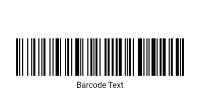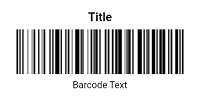The EAN-5 barcode is a supplemental barcode used to encode an additional five digits of data. It is typically found alongside the main EAN-13 or UPC-A barcodes. This supplemental barcode is used primarily in the publishing industry to provide additional information such as price, issue number, or other relevant data.
Developed as an extension to the EAN (European Article Number) system, the EAN-5 barcode was introduced to offer a standardized way to encode supplementary information. This addition ensures that more specific data can be included alongside the primary product identifier, enhancing the utility of barcodes in various applications.
Technical Specifications
EAN-5 encodes a five-digit numeric string, often used to convey supplemental information. Each digit is represented by a unique pattern of bars and spaces, with varying widths. The barcode begins with a start code, followed by the encoded digits, and a checksum for error detection.
The structure of the EAN-5 barcode includes:
- Start Code: Indicates the beginning of the barcode.
- Data Characters: Each of the five digits is encoded using specific patterns.
- Checksum: Ensures data integrity and accuracy during scanning.
Checksum Calculation
The checksum for the EAN-5 barcode is calculated using a modulo 10 algorithm:
- Multiply each digit by a weight that alternates between 3 and 9, starting with the first digit.
- Sum the results of these multiplications.
- Find the remainder when the sum is divided by 10.
- Subtract the remainder from 10 to get the checksum digit.
This calculated checksum digit is appended to the end of the barcode to ensure any errors during scanning can be detected.
Advantages and Disadvantages
The EAN-5 barcode offers the advantage of adding valuable supplemental information to primary barcodes without requiring significant additional space. This compact design is ideal for applications where detailed product information is necessary. The checksum ensures high data accuracy, reducing the likelihood of scanning errors.
However, EAN-5 is limited to numeric data, which can restrict its use in applications requiring alphanumeric or more complex data. Additionally, it cannot be used independently and must always accompany a primary barcode, such as EAN-13 or UPC-A, which may limit its standalone utility.
EAN-5 Applications
EAN-5 is extensively used in the publishing industry and other sectors where supplemental data is beneficial. It is commonly applied to:
- Magazines and Periodicals: Encodes issue numbers or publication dates, facilitating the management and sale of periodicals.
- Books: Used in conjunction with ISBN numbers to encode additional information such as price.
- Retail: Provides additional product details, aiding in inventory management and checkout processes.
Comparison with Other Barcode Symbologies
Compared to other barcode types, EAN-5 is specialized for adding supplementary information. While similar in function to the UPC-5, it is designed to complement the EAN-13 barcode system, ensuring compatibility with international standards. Unlike larger barcodes like Code 128, which can encode more complex data, EAN-5 is optimized for simplicity and space efficiency, making it ideal for specific use cases in retail and publishing.
The EAN-5 barcode is a practical and efficient tool for encoding supplemental numeric information. Its development has provided a standardized method to include additional data alongside primary barcodes, enhancing the ability to manage and track products more effectively. Despite its limitations to numeric data and dependency on primary barcodes, EAN-5 remains a valuable component in the barcode ecosystem, particularly in the publishing and retail industries.


